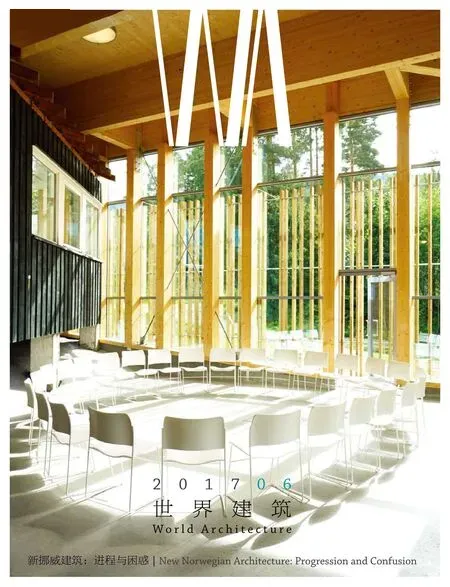斯瓦特拉蒙实验住宅,特隆赫姆,挪威
2017-07-12建筑设计ysom建筑事务所
建筑设计:Nøysom建筑事务所
斯瓦特拉蒙实验住宅,特隆赫姆,挪威
建筑设计:Nøysom建筑事务所

1鸟瞰/Aerial view
项目信息/Credits and Data
客户/Client: Svartlamon Housing Association
主持建筑师/Principal Architects: Trygve Ohren, Haakon Haanes, Cathrine Johansen Rønningen
自建者/Self Builders: Torfinn Borkhus, Siri Gjære, Guro Sletnes, John Strandskog, Per Kristian Nygård, Markus Lantto, Iacob Sømme
木工/Carpenter: Arnleiv Overgård
建筑面积/Floor Area: 5户每户约60~65m²,共计约350m²,含约50m²公房/5 houses of ca. 60~65m², in total ca. 350m² (including the common house of ca. 50m²)
基地面积/Site Area: ca. 500m²
材料/Materials: 木龙骨框架结构,混凝土桩基,木纤维隔热层,回收木板、回收波纹钢板、回收门窗和楼梯/ Timber stud frame construction; concrete pillar foundation; wooden fibre insulation; reused wooden planks, reused corrogated iron, reused windows, doors and stairs
造价/Cost: 3,000,000 NOK
设计时间/Design Period: 2013-2017
建造时间/Building Phase: 2015-2017
建成时间/Completion Time: 2017.08
摄影/Photos: Nøysom arkitekter (fig.4,17,18,23), Vigdis Haugtrø (fig.1,3,19-22)通风,尽可能少地借助复杂技术系统,以使得自建者能轻易理解这些房屋。

2 总平面/Site plan

3 自建者、建筑师和木工合影/The self builders, the architectsand the carpenter
该项目是对“可持续生活方式是可被购买的某种物品,可持续建筑全然关于能源效率”之观念的讨论与批评。可持续性,是以可得方式适应融入自身环境的能力。这正是斯瓦特拉蒙的自建者们通过建造自宅而学习到的。他们使用了远低于当今挪威常规水平的资源与能源,事实上这些房屋的建造仅仅花费了该地区记载价格的1/4。
在概念发展形成后,建筑师以协调人的角色参与到建造过程中,提供建议并协助自建者。另外还有一位斯瓦特拉蒙住房协会聘请的专业木工,以及社区其他居民也提供了帮助。自建者们并不会在建造完成后真正成为房主,他们将会以租借的形式向斯瓦特拉蒙住房协会租用这些房屋,该机构是一个非盈利组织,向特隆赫姆市租赁斯瓦特拉蒙的土地,然后出租给区域内的居民。对于这样的项目来讲,这是一个再完美不过的社区;作为一个社会实验区,在当前的挪威社会中也是与众不同的。这个项目显然成为了同类中的先行者,但愿它是第一个而不是最后一个。(陈茜 译)
斯瓦特拉蒙实验住宅项目位于特隆赫姆地区名为斯瓦特拉蒙的一个半自治城市实验研究区域。在这里,5个家庭借助极为有限的预算,从零开始建造各自的住宅。在新兴建筑实践机构Nøysom建筑事务所的计划中,他们的建造依靠大量的循环利用、环境友好材料、个人手工劳动与创造力来完成。
项目始于2013年,预计在2017年完成。Nøysom建筑事务所的特吕格弗·乌伦、哈康·汉尼斯和卡特琳·约翰森·朗宁根共同决定发起一项在斯瓦特拉蒙一处未被使用的实验地段进行的自建项目,作为特隆赫姆的挪威科技大学(NTNU)建筑学院自主课程学期的一部分。其后的两年中,在斯瓦特拉蒙居民自治会与自建者的相继参与下,继续发展了这项概念,直到2015年实际建造开始。
建筑师们提出了这样一种建筑框架——5座集中式联排住宅与一座公共房屋连接,自建者们使用近手可得的回收材料和零件,根据各自的需求与偏好进行适应性实施。主要的设计标准是,住宅的建造除管道和电气部分外能在无需专家协助的状况下简易完成,住宅能够与斯瓦特拉蒙的底层木质住屋相协调,住宅的生态足迹尽量小。住宅将实现自然

4 建造中外立面/Project in progress

5 联排住宅标准平面/Standard plan for the compact row houses

6 项目组织图示/Organisation behind the project
Svartlamon experimental housing project is located in a semi autonomous urban experimental research area called Svartlamon in Trondheim. Here five families are building their own houses from scratch with a very limited budget, relying on a lot of reuse, environmentally friendly materials, and their own manual labour and creativity, in a scheme developed by the young architectural practice Nøysom arkitekter.
Set to be finished in 2017, the project can trace its roots back to 2013, when Trygve Ohren and Haakon Haanes, who together with Cathrine Johansen Rønningen is Nøysom arkitekter, decided to initiate a self build project at an unused experimental site at Svartlamon as a part of a self programmed semester at architecture school NTNU in Trondheim. During the next two years they continued to develop the concept with participation from the resident democracy at Svartlamon, and later the self builders themselves, before the actual building started in 2015.
The architects developed an architectural framework of five compact row houses connected with a common house, that the self builders would be able to adapt to their own needs and preferences using what they could find of reused materials and components. The main design criteria were that the houses should able to be built easily without specialists (except the plumbing and electricity), and that they would fit into the existing structure of low-rise wooden buildings at Svartlamon, and that they would have a small ecological footprint. They would be naturally ventilated, and rely on as few complex technological systems as possible, to make the houses understandable by the self builders.
The project is a comment on and critique of the notion that a sustainable lifestyle is something you can buy, and that sustainable architecture is all about energy efficiency. Sustainability is about being able to adapt to one's own environment using means that are available, and this is what the self builders at Svartlamon are learning to do by building their own homes. They are also using much less resources and energy than what is considered normal in Norway today, which is supported by the fact that the houses are being built for about 1/4 of market price in the area.
After the concept was developed the architects have been part of the process as facilitators, giving advice and helping the self builders. There is also a professional carpenter employed by the housing association at Svartlamon helping out, as well as the rest of the community. The self builders will not actually own their house when its finished, but will rent it from the housing association at Svartlamon, which is a non-profit organisation that leases the land at Svartlamon from the city of Trondheim, and rents it out to the residents in the area. It is the perfect community for a project like this, and as an urban experimental area it is unique in Norway at the present time. The project is the first of its kind in Norway, but it is hopefully not the last.
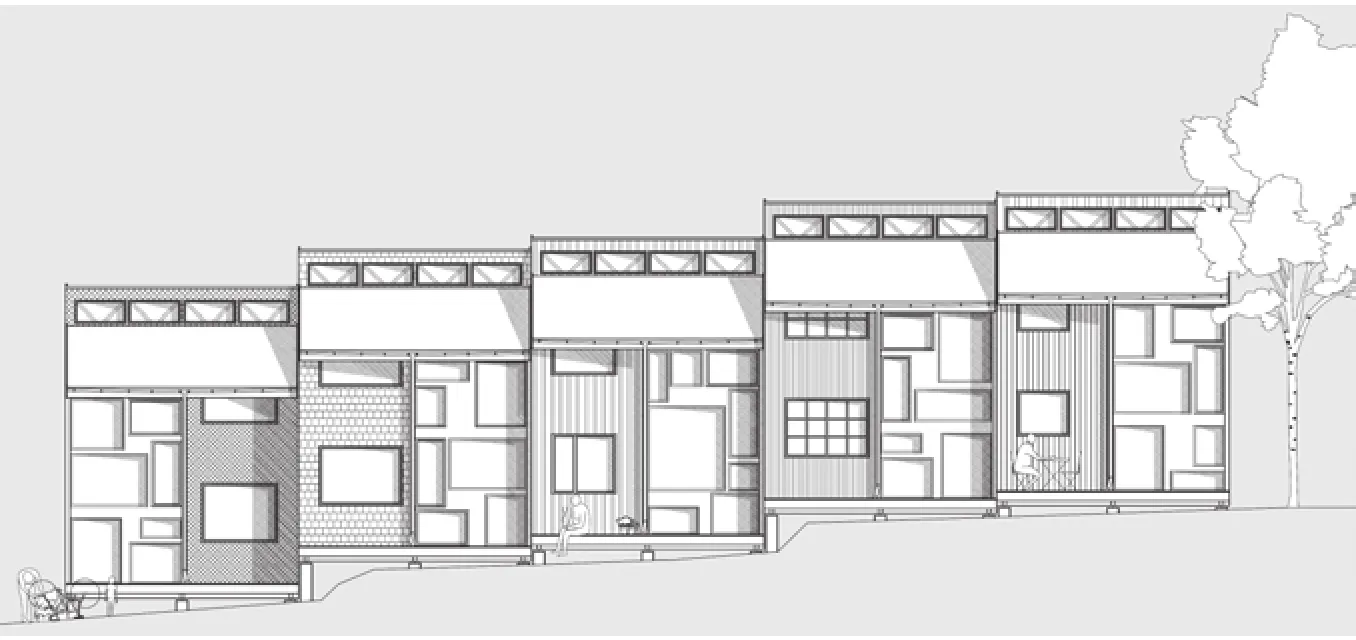
7 联排住宅西南立面(概念设计)/Southwest elevation of the row houses (concept drawing)

8 联排住宅东北立面(概念设计)/Northeast elevation of the row houses (concept drawing)
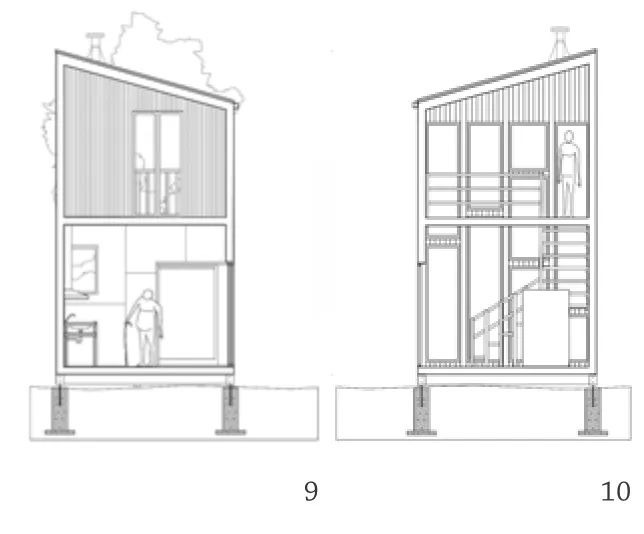
9.10 公共房屋剖面(概念设计)/Sections of the common house (concept drawing)
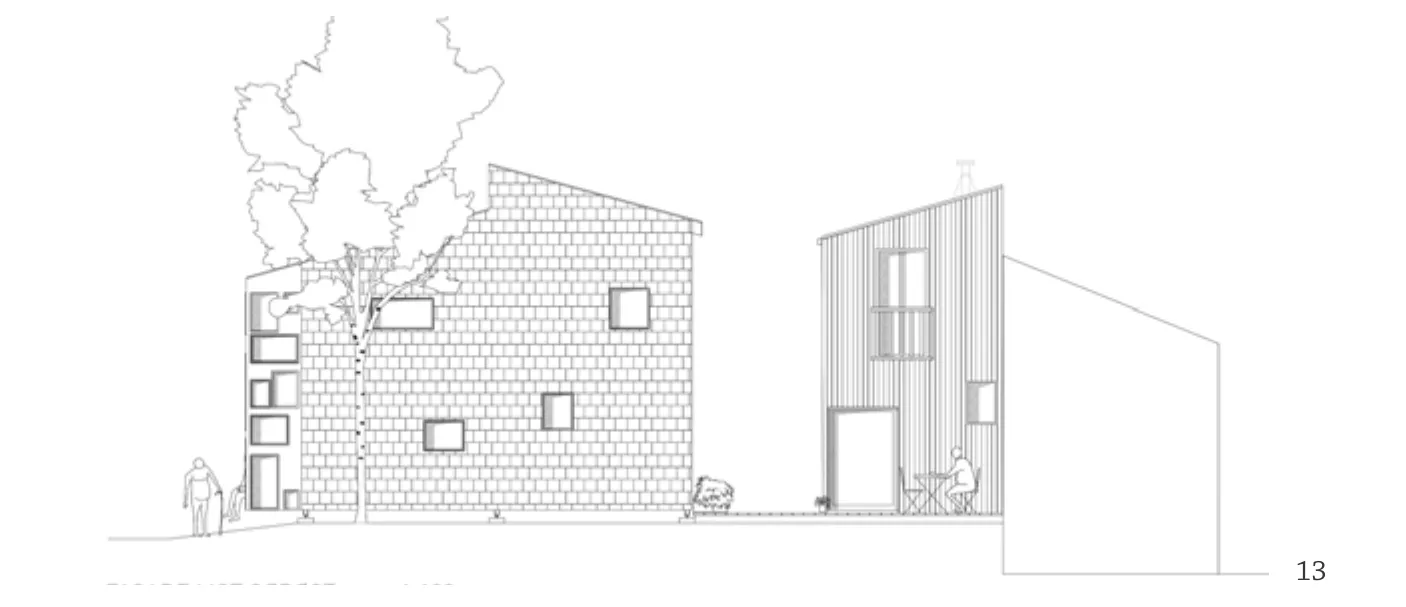
13 东南立面(概念设计)/Southeast elevation (concept drawing)

11 公共房屋西南立面(概念设计)/Southwest elevation of the common house (concept drawing)
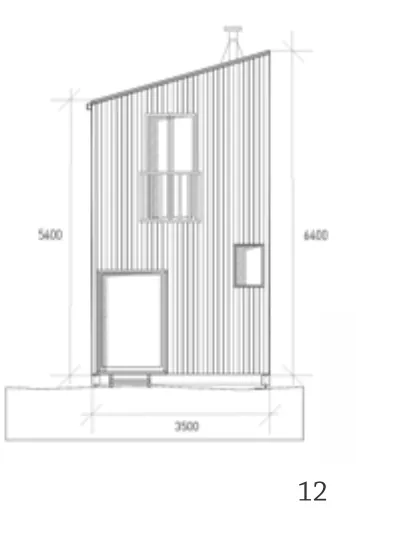
12 公共房屋东北立面(概念设计)/Northeast elevation of the common house (concept drawing)

16 联排住宅建造过程图示/Evolution of the row houses

17 联排住宅建造中的山墙/Row houses' gable walls in progress

18 联排住宅外景/Exterior view of the row houses
评论
周宇舫:作为社会实验,这个项目提供了一种建造模式,与此同时,建筑师在其中所扮演的角色——协调人,这对当代建筑师的职业属性是一种补充。基于自建和空间协商的建造行为,可以被看作是人类“聚落”形成和发展的内在动力,而对应当代人居环境的语境来说,本项目提供的启示还在于使用普通的建造技术因地制宜地创造适宜生活环境,而非换取所谓的可持续性。只有当作为住所的房屋中留存了自我的愿景和付出,才可以被称为“家宅”,而成为富有诗意的记忆。
王韬:用200字来评述这样一个包含着巨大社会与技术雄心的项目几乎是不可能完成的任务,我只能用一些关键词来描述它的复杂特征:绿色、可持续、居民参与、旧城改造……不同的是这些我们耳熟能详、司空见惯的关键词,在这个项目中都有了具体而微的目标与措施,成为了有主人公和情节的每一个家庭的故事。建筑设计在这个项目中获得了一种新的意义,不再是一个静态的作品,而是一个指向具体日常生活的过程。
Comment
ZHOU Yufang: As a social experiment, this project provides a model of construction as well as the role of architects - coordinator, which is a supplement to the professional attributes of contemporary architects. The self-built and spatial negotiation behaviour can be regarded as the internal driving force of the formation and development of human "settlement".The revelation provided by this project lies in the use of common construction technology to create a suitable living environment, rather than in exchange for the so-called sustainability. Only when the house shares the ambition and hard work of its residents, can it be called "home" and become a poetic memory. (Translated by QI Yiyi)
WANG Tao: Describing a project with such huge ambition for society and technology in some 200 words is almost an impossible task. I can only use some key words to describe its complex characteristics: green, sustainable, residents participation, old town renovation... but what's new is that all of these key words we are familiar with have been given specific purposes and solutions in this project, and became the stories of every family that have their characters and plot. Architecture design has been given a new definition in this project: it's no longer a static work, but a procedure that points to daily life. (Translated by CHEN Yuxiao)
Experimental Housing at Svartlamon, Trondheim, Norway, 2017
Architects: Nøysom arkitekter
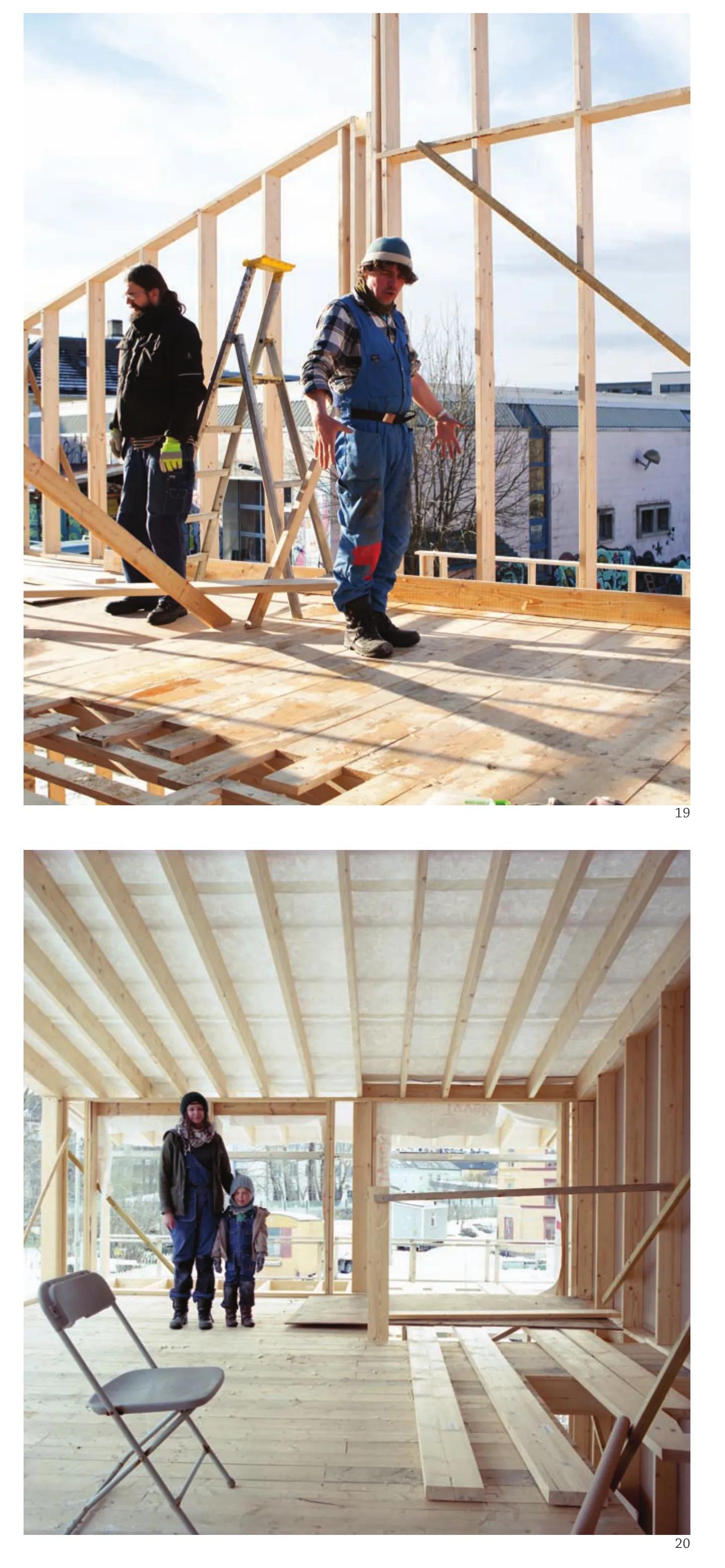
19.20 自建者在施工现场/Self builders on site

21-22 自建者在施工现场/Self builders on site

23 建筑师检查房屋地基/Architect inspecting the foundation

24.25 公共房屋平面(概念设计)/Plans of the common house (concept drawing)
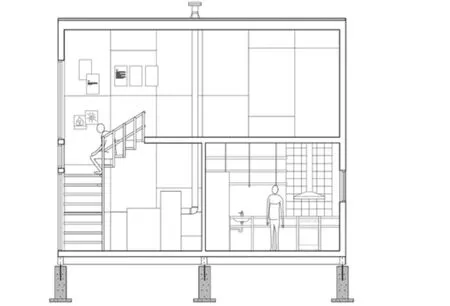
26 公共房屋剖面(概念设计)/Section of the common house (concept drawing)

27 公共房屋西南立面(概念设计)/Southwest elevation of the common house (concept drawing)
